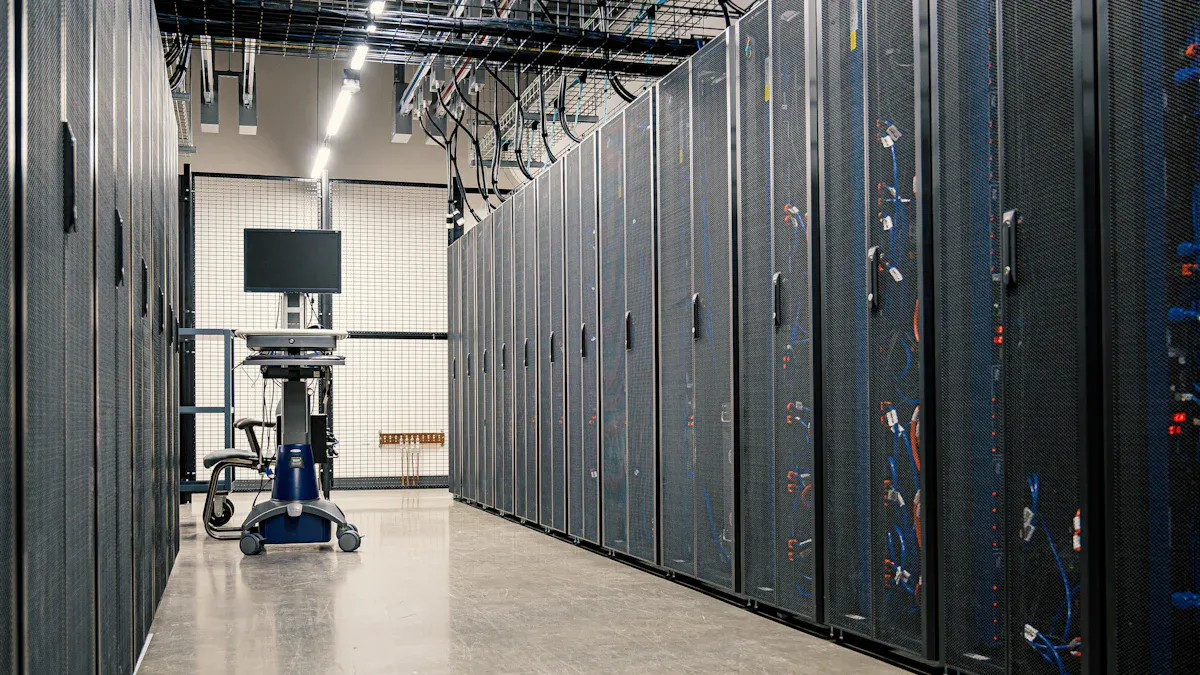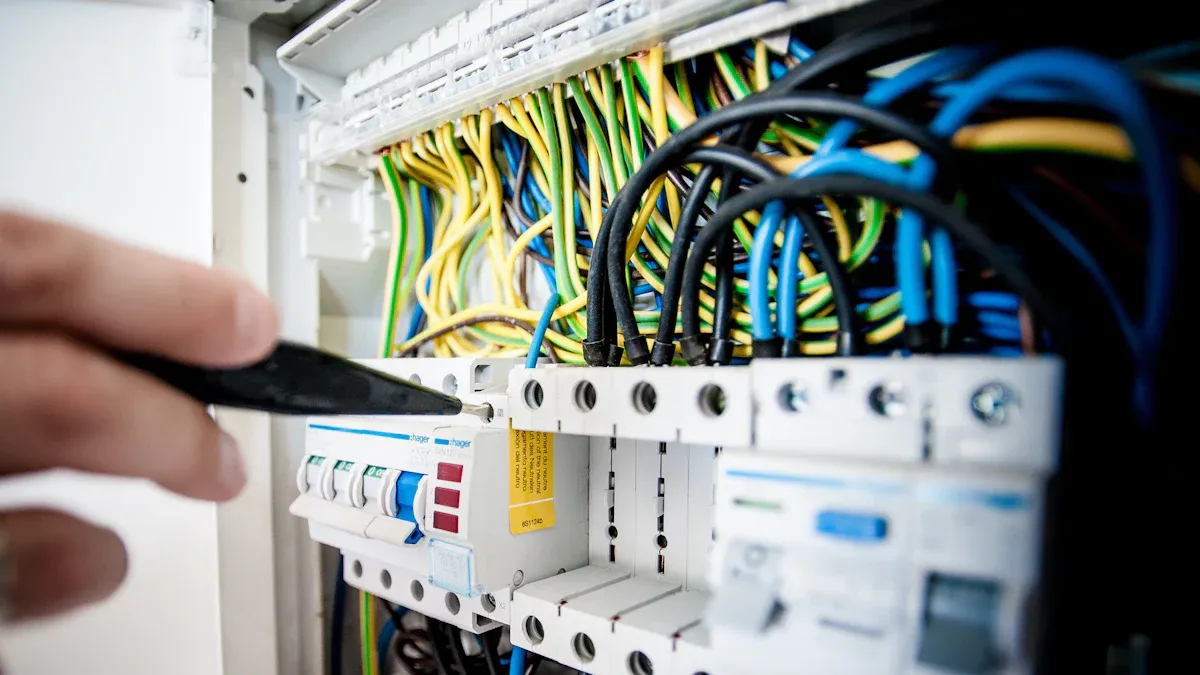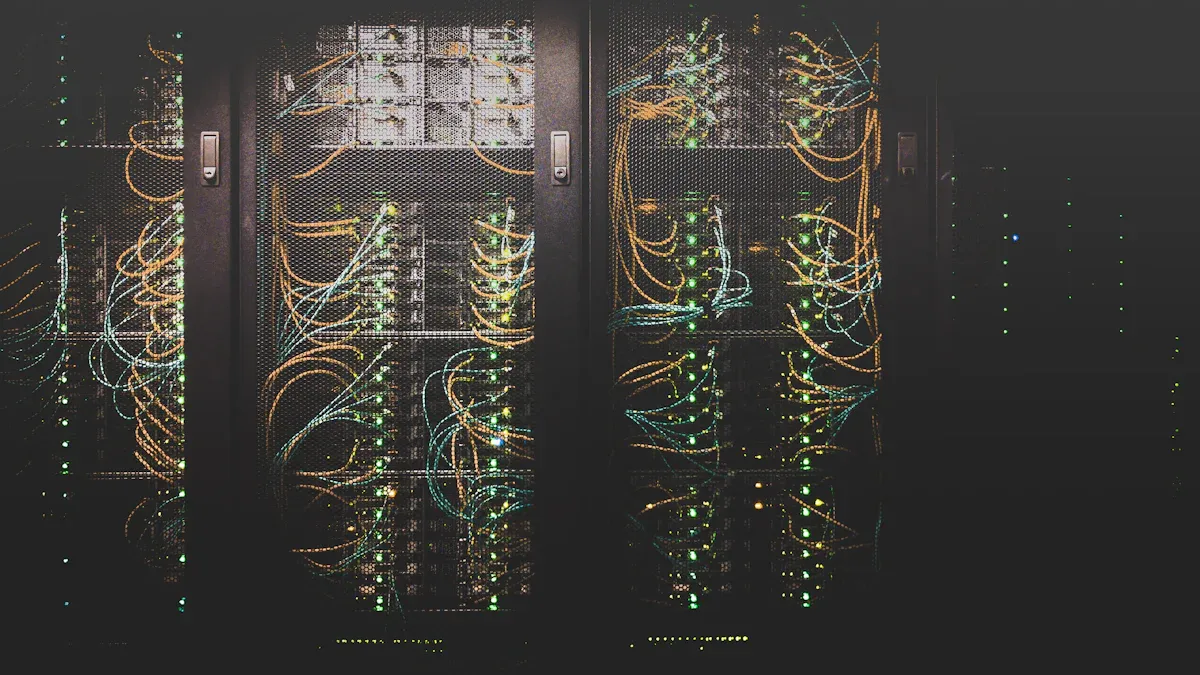ESTEL's Guide to Power Distribution Units and Their Purpose

A power distribution unit (PDU) is essential for spreading electricity from one source to many devices. Power distribution units are commonly utilized in IT rooms and data centers, where they help manage power safely and efficiently. Data centers consume about 2% of the world's energy, making tools like power distribution units crucial for energy conservation. As technology advances and the demand for data increases, power distribution units become even more necessary. They ensure that systems operate smoothly while simultaneously saving energy.
Key Takeaways
Power Distribution Units (PDUs) send power from one source to many devices. They help manage electricity well in data centers.
Pick PDUs with load-balancing to stop damage and keep systems steady during heavy use.
Smart PDUs check energy use and room conditions. They find waste and save energy, which cuts costs.
Get PDUs with surge protection to protect devices from power surges and keep them working safely.
New PDUs let you control and check them from far away. This makes work easier and reduces downtime.
Key Functions of Power Distribution Units
Power distribution and load balancing
A power distribution unit (PDU) helps send electricity to many devices. It works as a hub, sharing power from one source to several systems. This is very useful in places like data centers with many servers. Without proper power sharing, some devices may get too much power, while others get too little. This can cause problems or even damage equipment.
Another important job of a PDU is load balancing. It spreads the electrical load evenly across circuits to avoid overloading. This helps prevent power outages and keeps systems running well. Some advanced PDUs can check the load on each outlet and adjust it automatically. This feature ensures your systems stay stable, even when usage is high.
Tip: Choose a PDU with load-balancing features to improve system reliability.
Monitoring power usage and environmental conditions
Modern PDUs do more than just share power. They also track power use and check environmental factors. For example, smart PDUs can measure energy use at each outlet. This data helps find waste and save energy, cutting costs.
Checking the environment is also important. Things like temperature, humidity, and air quality affect how well equipment works and lasts. Many PDUs have sensors to monitor these in real time. This lets you fix issues, like adjusting cooling, to keep conditions ideal.
Factor | How It Affects Power and Environment |
|---|---|
Power Quality | Impacts how reliable and efficient data center operations are, following standards like ASHRAE and ITIC. |
Environmental Conditions | Temperature, humidity, and air quality affect hardware performance, lifespan, and cooling efficiency. |
Monitoring Systems | Tools like DCIM and PQMs help track power and environment, reducing downtime and failures. |
Compliance Standards | ASHRAE rules ensure good conditions for equipment, affecting contracts with large-scale users. |
Using these monitoring tools helps you manage power better and keep equipment in top shape.
Surge protection and power reliability
Power surges can harm your devices, leading to expensive fixes. A PDU with surge protection shields your equipment by absorbing extra voltage during surges. This is especially helpful in areas with unstable power or frequent storms.
Reliability is another key feature of a PDU. Advanced models provide steady power, even during unexpected issues. Some have automatic switches that move to backup power if the main source fails. This ensures your systems keep running, which is critical in places like data centers.
Key Findings | Details |
|---|---|
Smart Meters in Kyrgyz Republic | Smart meters connect 20% of users, reducing complaints and helping with billing during COVID-19. |
Infrastructure Improvements in Karachi | ABC wiring cut losses by 8% and raised revenue by 5%, improving trust and lowering complaints. |
Customer Experience | Areas with ABC wiring had fewer blackouts, showing better power reliability. |
Investing in a PDU with surge protection and reliability features helps protect your devices and ensures smooth operations.
Remote power management capabilities
Remote power management lets you control PDUs from anywhere. This is helpful in data centers with many devices to manage. You can turn outlets on or off and restart devices remotely. It also allows you to check power usage without being there.
Modern PDUs with remote features offer many advantages:
Monitoring PUE (Power Usage Effectiveness): Track energy use and find ways to save.
Environmental management: Check rack conditions like temperature and humidity remotely.
Quick troubleshooting: Get alerts about problems and fix them faster.
Metric | Description |
|---|---|
Fewer and shorter outages | Spot and fix problems early to avoid downtime. |
Better maintenance | Find power issues and improve equipment performance. |
Manage renewable energy | Control energy sources for better efficiency. |
Boost power distribution efficiency | Monitor energy use and lower costs by reducing PUE. |
Fair energy billing | Measure energy use accurately for fair billing and planning. |
Remote power management makes operations smoother and more efficient. Adjusting power and cooling systems saves energy and improves performance. If problems happen, remote tools help fix them quickly, keeping everything running well.
Tip: Pick a PDU with remote features to save time and boost efficiency in your data center.
Redundancy for uninterrupted operations
Redundancy in PDUs keeps systems running during unexpected failures. This is vital in data centers where downtime can be costly. Backup power paths in redundant PDUs ensure systems stay on if the main source fails.
Advanced PDUs with Automatic Transfer Switch (ATS) improve reliability. They switch to backup power automatically when needed. Facilities using ATS PDUs report 25% better reliability. Switched PDUs, which control individual outlets, cut downtime by 15% compared to basic PDUs.
Here’s how redundancy helps your systems:
Better uptime: Backup power keeps systems running during outages.
Higher reliability: Automatic switching reduces the chance of power loss.
Less downtime: Switched PDUs speed up recovery from power problems.
Using redundant PDUs protects your equipment and ensures smooth operations, even in tough situations.
Note: Redundancy is key for critical systems. It ensures your work continues without power interruptions.
Types of Power Distribution Units

Basic PDUs and their uses
A basic PDU is a simple tool that shares power with many devices. These PDUs are dependable but don’t have features like monitoring or remote access. They are often used in places where low cost and simplicity matter, like small server rooms or electric vehicle (EV) setups.
Basic PDUs help keep systems safe and steady. For example:
They stop circuits from overloading, which can harm devices.
Well-made units make EV power systems work better.
They lower the chance of voltage changes that cause downtime.
But basic PDUs have limits. They can’t handle big voltage spikes or strong power surges well. This might trip breakers or make devices act up. Even with these limits, basic PDUs are still useful for setups that don’t need advanced features.
Smart PDUs and their special features
Smart PDUs are more advanced and offer better power control. They let you monitor power, control devices remotely, and manage energy smarter. These are great for important places like data centers or big buildings where reliability is key.
New tech has made smart PDUs even better. Some now work with renewable energy, use blockchain for secure data, and support Power-over-Ethernet (PoE). Others use AI and IoT to predict problems and manage power automatically. These features make smart PDUs reliable and energy-efficient, perfect for modern needs.
Comparing basic and smart PDUs
Choosing between basic and smart PDUs depends on what you need. The table below shows the main differences:
Feature | Basic PDUs | Smart PDUs |
|---|---|---|
Power Sharing | Simple power sharing without extras | Advanced power control with live monitoring |
Monitoring | No monitoring | Tracks power use in real time |
Control | Manual only | Remote control and automation |
Extra Features | None | Tracks environment and sends alerts |
Basic PDUs work well for simple setups, while smart PDUs are best for complex systems needing detailed power control. Pick the one that fits your needs and budget.
PDU Form Factors and Their Applications

Rack-mounted power distribution units
Rack-mounted PDUs fit inside server racks to supply power. They are great for businesses needing efficient power sharing. These PDUs also have features like power tracking and load balancing. Built-in meters check power quality to spot and fix problems early. Smart rack-mounted PDUs save energy and help manage data center space better.
Power needs in businesses have grown over time. For example:
Year | Average Rack Power Need (kW) | Notes |
|---|---|---|
2016 | 10.5 | Starting average rack power need |
2019 | 11.7 | Power needs increased |
2021 | 12.02 | Power needs kept rising |
N/A | 17kVA or more | Usual rack wiring capacity |
N/A | 57kVA | Highest rack capacity seen |
Rack-mounted PDUs are key for today’s data centers. They are compact and reliable, making them perfect for high-power setups.
Floor-mounted power distribution units
Floor-mounted PDUs handle large facilities with high power needs. They send power from the main source to different circuits. These PDUs meet the growing demands of high-power setups. Data centers with high-density racks can use up to 25kW per rack. Big facilities often average around 15kW per rack. As new servers and equipment appear, power needs keep increasing.
Floor-mounted PDUs are crucial for big operations. They are strong and can handle heavy power loads, ensuring smooth power delivery.
Cabinet-mounted power distribution units
Cabinet-mounted PDUs protect sensitive devices in closed spaces. They control power flow from the main source to multiple outputs. This ensures steady power for all devices in the cabinet. Many cabinet-mounted PDUs include features like surge protection and overcurrent safety. These features protect devices from electrical harm.
Smart cabinet-mounted PDUs have sensors to track temperature and humidity. These sensors send data to DCIM systems, helping improve operations and protect equipment.
Evidence Description | Key Points |
|---|---|
Role of PDUs in Data Centers | PDUs help with power control, tracking, and environment monitoring. |
Features of PDUs | Smart PDUs collect data and work with DCIM systems. |
Cabinet-mounted PDUs are best for setups needing careful power control and extra device protection.
Portable power distribution units
Portable power distribution units (PDUs) are handy tools for supplying power anywhere. They are small, easy to carry, and perfect for temporary setups. Whether it's an outdoor event, a construction site, or a home office, portable PDUs provide steady power to your devices.
These PDUs are very helpful for short-term setups. For instance, they are crucial during events like political rallies. They power important systems like lights and sound equipment, ensuring everything runs smoothly. Similarly, outdoor sports venues and stadiums use portable PDUs to handle high energy needs. They keep lights, speakers, and other systems working well, improving the experience for everyone.
At home, portable PDUs are becoming more common. With more people working remotely, stable power is essential. Portable PDUs power smart devices, computers, and other electronics reliably. They help prevent interruptions, so your work and daily tasks go on without problems.
Here are some main advantages of portable PDUs:
Flexibility: Move them easily to different places when needed.
Reliability: Deliver steady power, even in tough conditions.
Ease of Use: Simple to set up and operate for anyone.
Tip: When picking a portable PDU, think about how many devices you need to power and the total energy required. This helps you choose the right unit for your needs.
Portable PDUs are great for temporary and mobile power needs. They are a smart choice for events, workspaces, and homes, keeping everything running smoothly wherever you are.
Benefits of Using PDUs in IT and Data Centers
Enhanced uptime and reliability
Power distribution units (PDUs) help keep data centers running smoothly. They provide a steady flow of electricity to all devices, reducing power interruptions. This is very important for Tier 2 and Tier 3 facilities, where downtime can cost a lot of money. As digital systems grow, the need for PDUs increases. Features like smart monitoring and remote control make PDUs even more reliable for modern setups.
The rise of data centers worldwide shows why PDUs are essential. In 2023, there were over 850 hyperscale data centers. These centers support cloud computing and AI, which need reliable power. Advanced PDUs help ensure systems stay online and avoid costly downtime.
Segment | 2023 Value (USD) | Projected Value (USD) by 2032 |
|---|---|---|
Tier 2 | Over 700 million | Exceed 1 billion |
Tier 3 | N/A | N/A |
Tip: Pick PDUs with smart monitoring to avoid unexpected power issues.
Improved operational efficiency
PDUs make data centers work better by saving energy and managing power well. They balance power use, which reduces waste and improves efficiency. For example, better Power Usage Effectiveness (PUE) helps delay expensive upgrades and use resources wisely.
Modern PDUs also support virtualization, which simplifies operations. With remote control features, you can quickly find and fix problems. This saves energy and keeps your data center running at its best.
Callout: Using PDUs to improve efficiency saves energy and lowers costs. It’s a smart choice for any data center.
Scalability for growing infrastructure needs
As data centers grow to handle AI, IoT, and other tech, PDUs help them scale up easily. High-density PDUs can manage the extra power new equipment needs. This makes it simple to expand without issues.
The PDU market is growing fast. By 2034, it’s expected to be worth 12.89 billion USD, with a yearly growth rate of 6.36% from 2025 to 2034. This growth comes from edge computing, renewable energy, and energy-saving efforts.
Metric | Value |
|---|---|
Projected Market Value | 12.89 billion USD by 2034 |
Compound Annual Growth Rate (CAGR) | 6.36% from 2025 to 2034 |
Key Drivers | Demand from data centers, telecommunications, and healthcare |
Note: Using PDUs for scalability helps you grow without losing efficiency or performance.
Better power usage analytics and cost management
Power distribution units (PDUs) help track energy use and cut costs. They show where power is wasted, helping you make smarter choices. This improves how resources are used and lowers expenses.
Modern PDUs have tools that make power tracking easier. They group devices by energy use, showing patterns clearly. For example, grouping devices can uncover wasteful energy habits. Fixing these problems helps your system work better.
PDUs also combine many measurements into one summary. This makes it faster to study energy data. By spotting trends, you can find where energy is wasted and fix it.
PDUs can also find problems automatically. If power use changes suddenly, it might mean a machine is broken. Alerts help you fix issues early, saving time and money.
Feature | Benefit |
|---|---|
Grouping Devices | Shows hidden energy waste for better management. |
Makes energy analysis quicker and easier. | |
Problem Alerts | Finds broken machines early, cutting repair costs. |
Energy Fixes | Targets wasteful devices for upgrades or replacement. |
PDUs help replace or upgrade machines that waste energy. This lowers bills and makes your setup more eco-friendly.
Tip: Pick PDUs with smart tools to find waste and save money.
With PDU insights, you can control energy use better. This leads to smarter spending on equipment and keeps costs low while systems run efficiently.
Power distribution units (PDUs) are important for sharing electricity effectively. They keep IT systems and data centers running smoothly and reliably. With features like monitoring, load balancing, and remote control, PDUs help save energy and prevent downtime.
Real-world examples show how PDUs make a difference:
Company | What They Did | Energy Benefits |
|---|---|---|
Used machine learning to improve cooling and cut standby power. | Saved 40% on energy use. | |
Added evaporative cooling and virtualized servers. | Achieved a low PUE score of 1.06. | |
Microsoft | Used free cooling and renewable energy sources. | Lowered energy use and reduced emissions. |
Apple | Built solar panels and used natural cooling methods. | Earned LEED Platinum certification. |
These examples show how PDUs help save energy and support sustainability. Check out ESTEL's PDUs for reliable and efficient solutions that fit your needs.
FAQ
What is the difference between a PDU and a UPS?
A PDU shares power with devices, while a UPS gives backup power during outages. PDUs are for spreading electricity, and UPS units help when power fails. Both are often used together in data centers.
How do you choose the right PDU for your setup?
Think about your power needs and how many devices you have. Basic PDUs work for simple setups, while smart PDUs offer advanced features. Always check if the voltage and outlets match your equipment.
Can PDUs help reduce energy costs?
Yes, smart PDUs track energy use and find waste. They help you save energy by improving how power is shared. Adjusting usage based on their data can lower your energy bills.
Are PDUs necessary for small server rooms?
Yes, small server rooms also need PDUs. They stop overloading and keep power steady. Basic PDUs are cheap and provide safety, making them great for smaller setups.
Do PDUs require maintenance?
Yes, maintaining PDUs keeps them working well. Check for loose wires, clean dust, and test features. Smart PDUs often have tools to find and fix problems easily.
See Also
Understanding ESTEL PDUs and Their Importance in Data Centers
An Introductory Overview of Telecom Power Supply Systems
Telecom Cabinet Essentials: A Guide by ESTEL for Equipment
Ensuring Correct Voltage in Communication Cabinets with ESTEL
CALL US DIRECTLY
86-13752765943
3A-8, SHUIWAN 1979 SQUARE (PHASE II), NO.111, TAIZI ROAD,SHUIWAN COMMUNITY, ZHAOSHANG STREET, NANSHAN DISTRICT, SHENZHEN, GUANGDONG, CHINA


